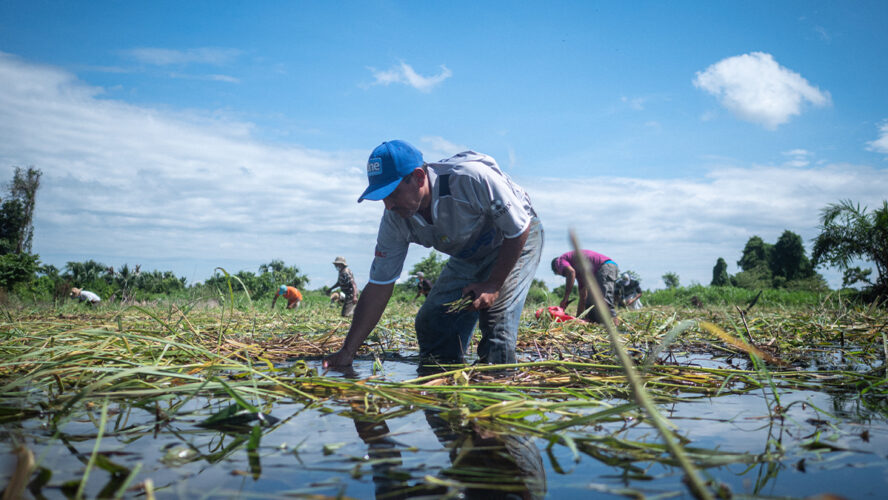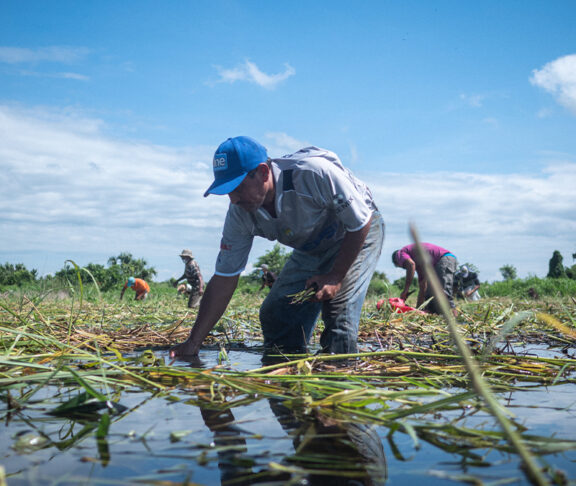When disaster strikes, the difference between devastation and resilience comes down to what happens before, during, and after the storm. That’s why the Caterpillar Foundation invests in embedding community resilience across four phases: strengthening infrastructure, preparedness, response, and recovery.

Asha Varghese
President, Caterpillar Foundation
Through this four-pronged approach to community resilience, the Caterpillar Foundation helps ensure communities are equipped to thrive in the face of tomorrow’s challenges.
1. Strengthening Infrastructure: Disaster resilience starts before a storm strikes
The Caterpillar Foundation focuses on helping disaster-prone communities feel confident in the face of challenges by investing in solutions to fortify built and natural infrastructure. The Foundation collaborates with organizations like the American Flood Coalition (AFC) to support flood-impacted communities, scale innovative solutions, and expand access to critical resources.
With the Foundation’s support, AFC launched the Flood Resilient Communities Cohorts, connecting six North and South Carolina communities to funding opportunities for resilience projects. Based on that pre-disaster work, after Hurricane Helene, Canton, N.C., received a tailored funding roadmap to pursue disaster recovery assistance. AFC estimates that effort within the Carolinas Cohort could help prevent over $252.7 million in future disaster-related losses.
2. Preparedness: It’s more than strengthening infrastructure — it’s uplifting the people that make up a community
The Caterpillar Foundation collaborates with organizations to provide the training, innovative technology, and critical supplies communities need before disaster hits.
The Foundation’s initiative with Myriad USA’s DisasterLink Network was developed to focus on shifting disaster philanthropy from reactive to proactive. DisasterLink Network ensures rapid, localized response for communities worldwide by linking donors instantly to key local organizations bearing the brunt of relief efforts. By supporting frontline charity organizations, the Foundation helps transform crises into opportunities for hope and recovery.
3. Response: When disaster strikes, every second counts
In addition to pre-disaster resilience efforts, the Caterpillar Foundation supports rapid, community-led responses to deliver help when and where it’s needed most.
As a member of the American Red Cross Annual Disaster Giving Program, the Foundation’s funding helps pre-position supplies, train volunteers, and develop innovative technologies that keep families safe and “Red Cross” ready. Each year, the Foundation’s support helps deliver educational resources and toolkits to communities worldwide. The Foundation also matches Caterpillar employee, retiree, and independently owned CAT® dealer employee contributions to the Red Cross through its Disaster Matching Program.
4. Recovery: Recovery is where resilience takes root
The Caterpillar Foundation collaborates with organizations like the Center for Disaster Philanthropy (CDP) to support long-term rebuilding — restoring infrastructure, revitalizing essential services, and helping communities emerge stronger.
After Hurricane Helene, the Foundation’s $350,000 donation to the CDP’s Atlantic Hurricane Recovery Fund helped local charities guide families through the long road to recovery. This support doesn’t end when the storm is over; it continues as communities rebuild, adapt, and prepare for the future.
Redefining disaster preparedness by empowering resilient communities
The Caterpillar Foundation believes disaster preparedness is a continuous journey — one that thrives on collaboration, innovation, and action at every stage. Through strategic investments, the Foundation helps communities shape their own paths to resilience. By supporting locally driven solutions, we can help ensure communities are equipped to face the challenges ahead with confidence and strength.


